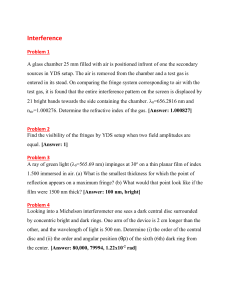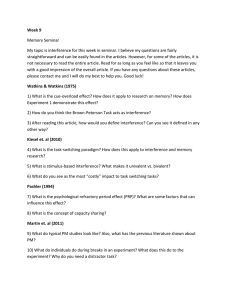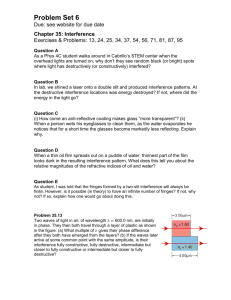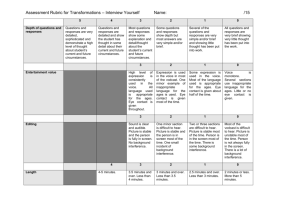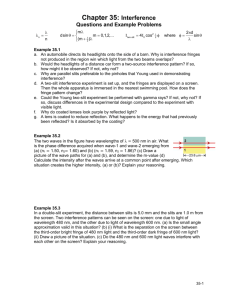Serway_PSE_quick_ch37
advertisement
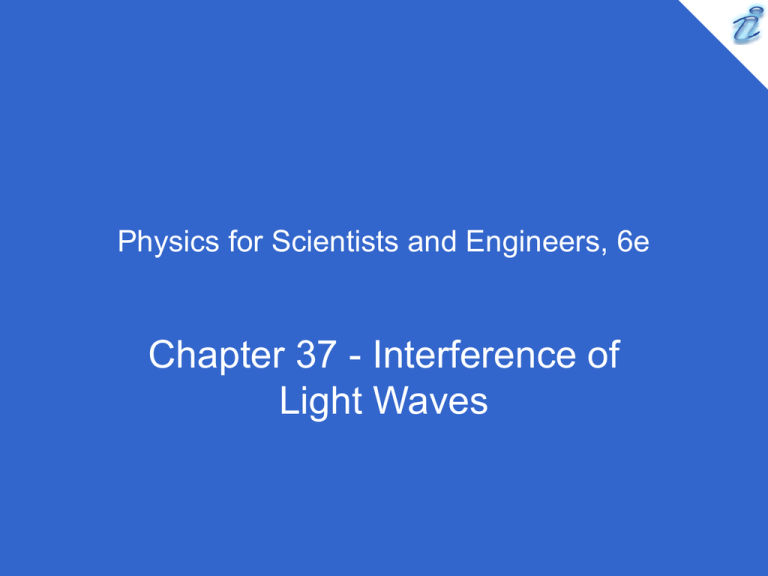
Physics for Scientists and Engineers, 6e Chapter 37 - Interference of Light Waves If you were to blow smoke into the space between the barrier and the viewing screen of Figure 37.5a, the smoke would show 1. no evidence of interference between the barrier and the screen 2. 1 50% 50% evidence of interference everywhere between the barrier and the screen. 2 3 4 5 1 2 The geometrical construction shown in Figure 37.5 is important for developing the mathematical description of interference. It is subject to misinterpretation, however, as it might suggest that the interference can only occur at the position of the screen. A better diagram for this situation is Figure 37.2, which shows paths of destructive and constructive interference all the way from the slits to the screen. These paths would be made visible by the smoke. In a two-slit interference pattern projected on a screen, the fringes are equally spaced on the screen 1 1. everywhere 2. only for large angles 3. only for small angles 2 3 4 5 33% 1 33% 2 33% 3 Equation 37.5, which shows positions y proportional to order number m, is only valid for small angles. Which of the following will cause the fringes in a two-slit interference pattern to move farther apart? 1. 1 decreasing the wavelength of the light 2. decreasing the screen distance L 3. decreasing the slit spacing d 4. immersing the entire apparatus in water 2 3 4 5 25% 25% 25% 25% 1 2 3 4 Equation 37.5 shows that decreasing λ or L will bring the fringes closer together. Immersing the apparatus in water decreases the wavelength so that the fringes move closer together At dark areas in an interference pattern, the light waves have canceled. Thus, there is zero intensity at these regions and, therefore, no energy is arriving. Consequently, when light waves interfere and form an interference pattern, 1. 1 energy conservation is violated because energy disappears in the dark areas 2. energy transferred by the light is transformed to another type of energy in the dark areas 3. the total energy leaving the slits is distributed among light and dark areas and energy is conserved 2 3 4 5 33% 1 33% 2 33% 3 Conservation of energy cannot be violated. While there is no energy arriving at the location of a dark fringe, there is more energy arriving at the location of a bright fringe than there would be without the double slit. In a laboratory accident, you spill two liquids onto water, neither of which mixes with the water. They both form thin films on the water surface. When the films become very thin as they spread, you observe that one film becomes bright and the other dark in reflected light. The film that is dark 1. 1 has an index of refraction higher than that of water 2. has an index of refraction lower than that of water 3. has an index of refraction equal to that of water 4. has an index of refraction lower than that of the bright film 2 3 4 5 25% 25% 25% 25% 1 2 3 4 One of the materials has a higher index of refraction than water, the other lower. For the material with a higher index of refraction, there is a 180° phase shift for the light reflected from the upper surface, but no such phase change from the lower surface, because the index of refraction for water on the other side is lower than that of the film. Thus, the two reflections are out of phase and interfere destructively. One microscope slide is placed on top of another with their left edges in contact and a human hair under the right edge of the upper slide. As a result, a wedge of air exists between the slides. An interference pattern results when monochromatic light is incident on the wedge. At the left edges of the slides, there is 1 1. a dark fringe 2. a bright fringe 3. Impossible to determine. 2 3 4 5 33% 1 33% 2 33% 3 At the left edge, the air wedge has zero thickness and the only contribution to the interference is the 180° phase shift as the light reflects from the upper surface of the glass slide.


